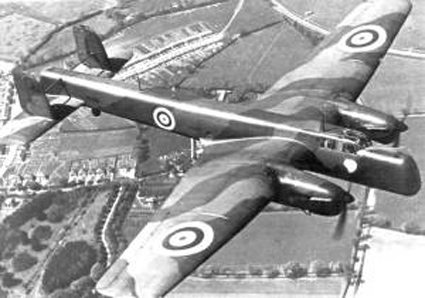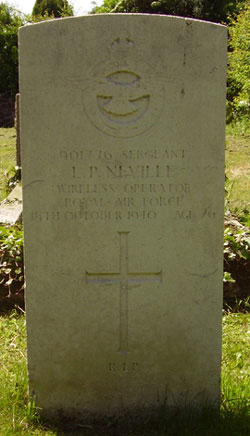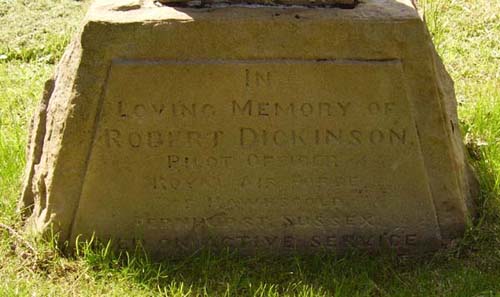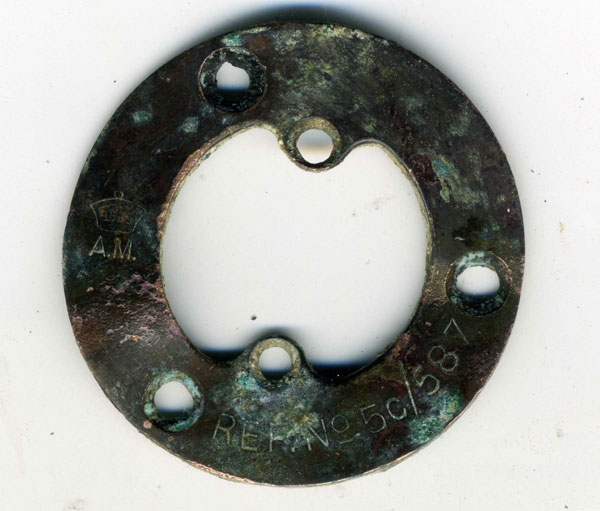This 10 Squadron aircraft took off from Leeming airfield at 17.27hrs on 14th October 1940 to undertake an operational flight to bomb a synthetic oil manufacturing plant at Stettin in northern Poland, on this night seventy eight aircraft took part in raids on this target and to other targets. Whitley T4143 left base and the route was then over the North York Moors crossing the coast near Ravenscar, crossing the North Sea and flying over the German island of Sylt and the Muritzsee to reach their target of Stettin. They bombed the target are in four waves all from 8,000 feet and made for
home. On their return to England the wireless failed and the crew were unable to pick up a diversion signal telling them to go to Marham airfield because of bad weather over
north-east England. At 04.30hrs the aircraft had been airborne for just over eleven hours and was running out of fuel, being unable to locate an airfield the crew were ordered
to abandoned the aircraft at 4500 feet in thick 10/10ths cloud. The Whitley came down in a field between Bagby and Thirsk on farmland near Green Dyke Farm but for some reason
two of the crew did not jump in time and their bodies were found in the wreckage, three others survived uninjured. The squadron record book adds further details about what
happened after the crew baled out, it stated that the pilot made his way to "Thirsk Lodge" and informed his base that he was staying there for the night. The second pilot and
air gunner later contacted their base and were told to proceed to Thirsk Lodge and report to their captain there. Leeming's station medical officer collected the three survivors
from Thirsk later that morning. One of the crew who did bale out, said to have been an air gunner (Sgt Somerville?), landed very close to a search light battery site near Thirsk.
Pilot - F/Lt Dennis Brendon Geoffrey Tomlinson RAF (37989).
Second Pilot - Sgt Thomas Augustine Byrne RAF (748546).
Observer - P/O Robert James Dickinson RAFVR (79372), aged 31, of Chelsea, London. Buried Leeming Churchyard, Yorkshire.
Wireless Operator / Air Gunner - Sgt Leslie Peter Neville RAFVR (901776), aged 26, of Forest Hill, London. Buried Leeming Churchyard, Yorkshire.
Wireless Operator / Air Gunner - Sgt Ronald Leslie Somerville RAFVR (970048).
Headstones of the two airmen killed. Robert Dickinson received his commission to the rank of P/O on probation on 19th May 1940. The CWGC entry states that his parents were
living in Chelsea where as his headstone states that he was from Hawkstone, Fernhurst, Sussex.
A wrist watch was found in the field of the crash in the years after the war and is rumoured to still be held behind the bar in the local pub at Bagby. Air historians Eric Barton, Ken Reast and Albert Pritchard sought permission from the land owner and field walked the site in Summer 2005 locating small fragments of the aircraft on the surface to confirm the crash location. The two photographs shown here are of items retained by Eric Barton from their visit.



Dennis Tomlinson had been awarded a commission to the rank of Acting P/O on probation on 4th August 1936 and later graded as P/O on 8th June 1937 having gained his Wings in December 1936
at Grantham. He rose to F/O on an unknown date and then to Acting F/Lt on 2nd March 1939. He made a forced landing a month prior to the Bagby incident only a few miles north of Thirsk
at Nether Silton and had his rear gunner jump from his aircraft on another flight (the aircraft returned to base). He was promoted to F/Lt on 3rd September 1940 and to Temporary
S/Ldr on 1st September 1941. He was awarded the DFC for service with 10 Squadron, Gazetted on 17th January 1941, but no citation has been located. He was posted to 10 OTU to instruct
after completing his first Tour but killed on 2nd June 1942 as the pilot of Whitley Z6581 on Ops to Essen. 10 OTU were asked to put up aircraft to increase the bomber force on this
night. S/Ldr Tomlinson DFC is buried in Gendringen Cemetery, Holland, he was twenty six years old.
Ronald Somerville survived the crash of Whitley P4994 at Leeming on 22nd December 1940. There is a possibility he was posted to 35 Squadron after his time with 10 Squadron. He
was certainly later posted to 159 Squadron but was sadly killed on 19th July 1942. He is buried in Khayat Beach War Cemetery, Israel and was twenty two years old.
Sgt Byrne was later posted to 76 Squadron. On the night of 5th/6th August 1941 he was the pilot of Halifax L9516 flying Ops to Karlsruhe when the aircraft crashed in Belgium and
all but one of his crew were made PoW's. One member of his then crew; F/Lt Thomas Barker Leigh RAF (46462), attempted to escape from captivity in what became known as the Great Escape,
he was captured and murdered by Lux and Scharpwinkle (members of the Gestapo) in April 1944. Another member of his then crew; Sgt Cyril Bruce Flockhart successfully escaped captivity
on an earlier occasion and was awarded the Distinguished Conduct Medal for these efforts after arriving back in the UK.
Whitley T4143 was built to contract 38599/39 by Armstrong Whitworth Ltd at Baginton and was awaiting collection on 7th August 1940. It was taken on charge by 10 Squadron at
Leeming shortly after 4th September 1940 as a replacement for Whitley P4967 which was lost on that date. The modern Air Britain aircraft serial record books state that on 21st
Septeber 1940 it sustained flak damage and returned to base where Cat.M/FB damage was recorded; however 10 Squadron's ORB states that it was not damaged on this date. Cat.W/FB(Burnt)
damage was recorded following the crash near Bagby in October 1940 but the engines were deemed re-usable in this stage in the War, they were given Cat.R damage and were probably
stripped and the parts used for spares.

